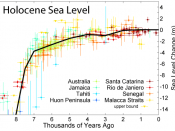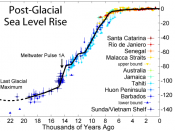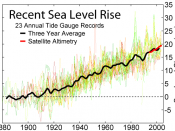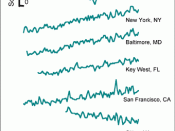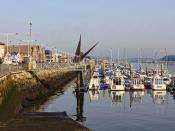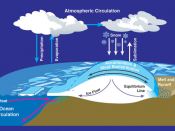There is much evidence that exists to suggest both positive and negative sea level change, geographical features such as rias, fjords, raised beaches and other features of emergence all are key evidence in exploring sea level change in historic times.
Ria is a Spanish word that means river mouth, and is used as a geographical term because of the many examples of rias on the coast of Galicia e.g. Ria de Pontevedra. They are formed by the drowning of lower reaches of a river and its tributaries. This occurred during the Holocene period, where many coastlines developed ria systems. They tend to form mainly where the geological trend is at a right angle to the shoreline. In the British Isles we can see some evidence of rias in Pembrokeshire, where all the rivers drain into Milford haven. Rias give evidence for an overall negative sea level change, probably most likely to Isostatic recovery, i.e.
the retreat of ice sheets taking pressure back off the land and the land therefore bouncing back, causing an overall fall in sea level.
Fjords are similar to rias but rather than come from drained V-Shaped river valleys they come from the more characteristically U-shaped glacial valley. They are mainly formed during the Holocene Transgression or Flandrian transgression where there was a rapid sea level rise. Fjords have steep sides and flat bottoms that contain very shallow water. Fjord coastlines tend to be best developed along high latitude coastlines where glaciation was most effective. For example the Norwegian coastline is the most fjord indented in the world, this coastline includes the 150km long Sognefjord. Fjords are also evident in the British Isles like in Scotland where Loch Broom and Loch Nevis are technically fjords although not as clear or as evident as in Greenland (independence Fjord) or Canada (Douglas Channel). Here we can obviously see locations that have experienced rapid positive sea level change mainly due to the Holocene Transgression, and as a result rias have formed.
Raised beaches are not such an obvious way of identifying negative sea level change but they are evidence nonetheless. These are beaches that are found high above the current beach level, sometimes on cliffs, or on any platform that can't be reached the tides. These beaches can be as high above the current sea level as 315m as is the case in Hudson Bay, Canada. In the British Isles the highest raised beach is on the Isle of Mull in Scotland where they been found at 37m above the current sea level. These raised beaches all tend to be formed from Isostatic movements, where sea levels have dropped considerably very rapidly.
As well as raised beaches, other features may occur as a result of coastal emergence. For example shore platforms can be raised up, and this is very evident in the tropics where platforms have formed high above the high tide mark. Barrier beaches may also occur when there is a fall in sea level. Cliffs of the "bevelled" profile type may evolve as a result of relative rise in sea level. Here we see formations that provide evidence to suggest a sudden fall in sea levels perhaps due to Isostatic recovery.
